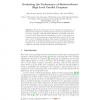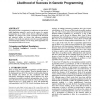78 search results - page 7 / 16 » A Case Study Using Automatic Performance Tuning for Large-Sc... |
ICCS
2004
Springer
14 years 1 months ago
2004
Springer
We show in this paper how to evaluate the performance of skeleton-based high level parallel programs. Since many applications follow some commonly used algorithmic skeletons, we id...
GECCO
2005
Springer
14 years 1 months ago
2005
Springer
This paper presents a comprehensive, multivariate account of how initial population material is used over the course of a genetic programming run as while various factors influenc...
ICDCS
2012
IEEE
11 years 10 months ago
2012
IEEE
Abstract—Modern day enterprises have a large IT infrastructure comprising thousands of applications running on servers housed in tens of data centers geographically spread out. T...
SIGMETRICS
1992
ACM
13 years 11 months ago
1992
ACM
To cope with the increasing difference between processor and main memory speeds, modern computer systems use deep memory hierarchies. In the presence of such hierarchies, the perf...
ICSE
2012
IEEE-ACM
11 years 10 months ago
2012
IEEE-ACM
Abstract—Customizable programs and program families provide user-selectable features to allow users to tailor a program to an application scenario. Knowing in advance which featu...


